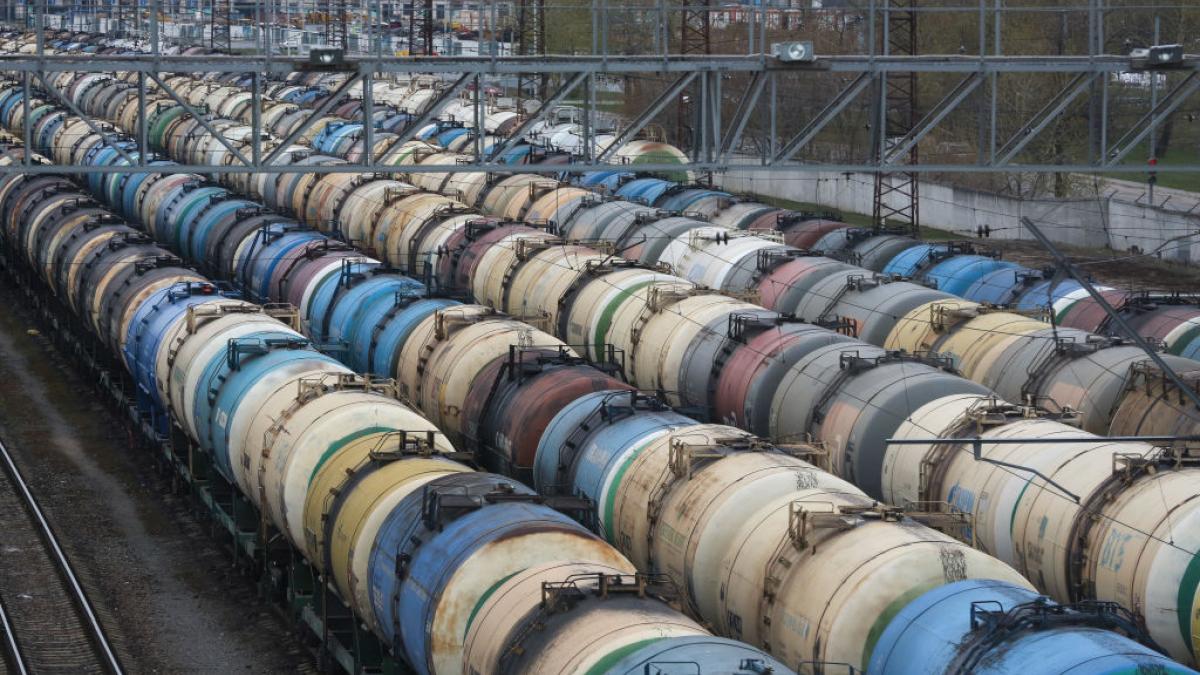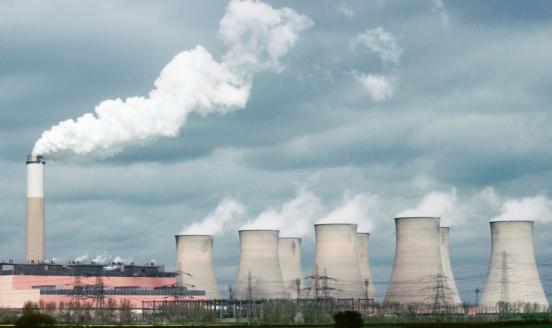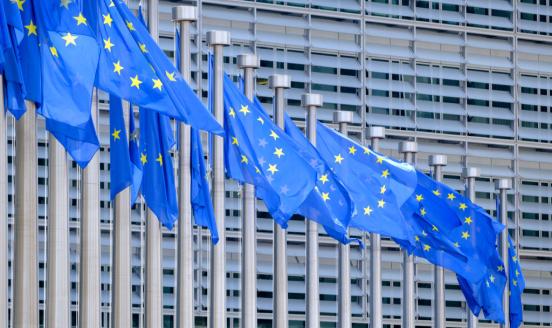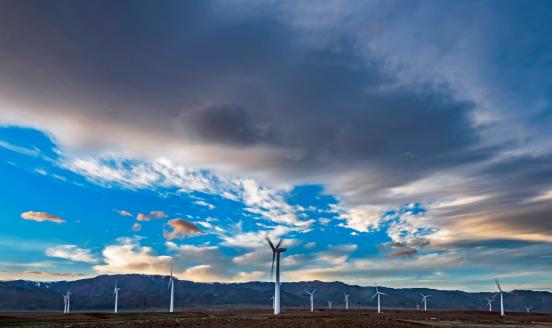How a European Union tariff on Russian oil can be designed
The European Union should apply a tariff on imports of Russian oil; it can be accompanied by a quota for a gradual, conditional phase-out.

A negotiation is underway between European Union leaders on restrictive measures to limit imports of oil from Russia. One option is a full and immediate import ban for crude oil and finished oil products such as diesel. The United States and United Kingdom have already adopted, respectively, an immediate ban and a phase-out plan. In the EU, some countries, wary of energy supply security, are resisting a full and immediate import ban.
A second option would be a tariff on Russian oil imports. This success of this would rely on the assumption that the EU can more easily find alternative oil suppliers than Russia can find alternative buyers. Pre-war, Russia exported 4.5 million barrels of oil per day to Europe and the US via Baltic and Black Sea ports; it would be difficult with current infrastructure and voyage times to redirect these flows to Asia. Whether extra Asian demand would even materialise is uncertain, and certainly only likely with substantial discounts. Russian producers would thus have an incentive to absorb most of the tariff burden, leading to significant reductions in windfall profits currently accruing to the Russian state.
Meanwhile, though there are challenges for the EU in replacing Russian oil, the bloc’s purchasing power will ensure it attracts oil from other suppliers (similarly to the LNG market where low Russian flows in Q1 2022 saw record total EU LNG imports). Moreover, EU countries sit on reserves equivalent to at least 90 days’ worth of oil net imports, and have scope to reduce demand through a range of smart measures – which are essential to demonstrate preparedness for a possible Russian cut-off of oil and/or natural gas flows to Europe.
An oil tariff: institutional choice and legal base
When considering the introduction of an EU tariff, a decreasing tariff-rate-quota during a transition period, or a full embargo on imports of Russian oil, a fundamental issue is whether such a measure must be agreed by all EU countries (unanimity), or can be adopted via a qualified majority vote.
EU sanctions on Russia so far have been based on Article 29 of the EU Treaty (Treaty on European Union, TEU) provisions on common foreign and security policy. The first step in this process requires a unanimous vote in the Council of the EU to adopt a political decision on restrictive measures (Article 31 TEU). Threats by Hungary to veto any sanctions on Russia oil suggest an alternative measure may be required.
Two alternatives, which would require only a qualified majority vote, could be EU common commercial policy (Article 207 of the Treaty on the Functioning of the European Union, TFEU) and energy policy (Article 194, TFEU). However, the choice is not discretionary. The EU Court of Justice has held that the appropriate legal basis of a European Union act “must rest on objective factors amenable to judicial review, which include the aim and content of that measure.” In cases where treaties contain several options for the adoption of an EU measure, the most specific legal basis must be chosen (CJEU, C-263/14, Parliament vs Council, para 43, 44).
It is clear, however, that the predominant purpose of an EU oil tariff would not be to govern commercial relations with Russia, while the EU treaties govern energy supply via Article 194 TFEU. This provision, however, is considerably qualified by its second paragraph, which delineates the exclusive competence of EU countries to choose between different energy sources and the general structure of their energy supply. An EU-wide measure limiting, taxing or banning energy imports as a matter of energy-supply policy would clearly infringe on these rights protected by Article 194(2) TFEU. In conclusion, qualified majority voting is not available for the adoption of an EU oil tariff.
Nevertheless, EU countries could adopt individual national taxes on imports of Russian oil. The design of such a tax and/or quantitative restrictions on oil imports from Russia could be coordinated via intergovernmental cooperation. A respective intergovernmental agreement on taxing Russian oil could be flanked by national measures that make it difficult for non-complying member states to obtain Russian oil.
Type of tariff: ad valorem vs. specific tariffs
A tariff rate can be expressed by reference to the value of the imported commodity (ad-valorem rate, eg 20% of the value), the volume of the imported commodity (eg €20/barrel), a mix (eg whichever is higher of 20% of the value or €20/barrel), or a compound (eg 10% of the value plus €10/barrel). The ad-valorem tariff is the most common, especially for goods with rather volatile prices. The EU applies ad-valorem tariff rates of 0% to 5% to imports of crude oil and oil products.
A further refinement would be to introduce a tariff-rate quota (TRQ). Within the determined quota, the tariff could be relatively low; beyond it, it could be relatively high (eg 5% for the first 2 million barrels/day, and 20% above that). This TRQ can be reduced over time and its flexibility would allow the tariff to be fine-tuned to achieve the desired political, economic and fiscal effects. For example, a TRQ could be implemented which phases Russian oil imports down to zero by the end of 2022.
Tariff rate and revenues
Russian oil production costs are estimated at $2-$5 per barrel. Including capital costs and transport costs, the breakeven price is estimated at $20 per barrel. The marginal tax system in Russia scales up dramatically above $25 a barrel; every $1 of profit above this price is taxed at a minimum of 80%. This provides a benchmark for the EU, as setting an import tax of 80% above $25/barrel would mimic the rent the Russian state extracts.
Making the simplified assumption that Russia’s reaction to tariffs would be linear (with a zero tariff Russia continues to sell current volumes to the EU; at a 100% tariff, they sell nothing to the EU), Table 1 shows different scenarios for the revenue accruing to the EU and volume of Russian oil imports. At a tariff rate of 80%, revenue could range between $14 million and $70 million per day. We treat crude oil and oil products together, which is an over-simplification – effective tariff design would consider different schedules for these differently priced goods.
Tariff revenues received by the EU and/or member-state budgets could be used to shield the least affluent EU consumers from high energy prices. The revenues could also pay for measures to support Ukrainian refugees in the EU, weapons in support of Ukraine’s defence, or the reconstruction of Ukraine. In this way, the tariff would not only significantly reduce Russian revenues, but would also to mitigate EU self-harm compared to a full and immediate import ban, while supporting Russia’s victims financially or in kind.
Anti-circumvention: preventing ‘grey’ sales to the EU
Anti-circumvention measures must play a prominent role. Already, Shell mixed 49% Russian diesel with 51% diesel of other origin, conferring non-Russian originating status onto Russian produce in order to disguise purchases of Russian oil. While such a practice is just about within the EU’s rules of origin for diesel and other oil products, an EU tariff should require the Russian content in any oil blend to be registered, specified and indicated, so it is taxable and penalties can be applied in case of non-compliance.
Oil from Kazakhstan fields which is exported from the Russian port of Novorossiysk can be blended with Russian oil or sold separately. The US oil ban does not apply to oil flowing through Novorossiysk as long as it is certified as originating from Kazakhstan. This distinction might become deliberately blurry. Efforts to help Kazakh oil reach markets through other routes, including by tanker via the Caspian Sea and the BTC-pipeline, or by replacing Russian oil exports to China via Kazakhstan with Kazakh oil, would reduce Kazakh reliance on Russian ports.
Russian crude can also be blended or disguised by ship-to-ship (STS) transfer. While STS transfers are legitimately used for moving oil between smaller vessels (suitable for entering ports) and larger tankers (suitable for travelling longer distances), they have been used by countries including Iran and Venezuela to evade sanctions. Analysts report sightings of ships notorious for moving Iranian oil at Russian ports during the second half of April as well as an uptick in Russian tankers ‘going dark’ by turning off tracking devices. It will be a tall order to monitor potential evasion of sanctions, but initiatives are already underway, including as the Russian Tanker Tracking Group (RTTG) launched by the Ukrainian government. Collaboration should be sought with commodity traders (many with headquarters in Switzerland).
The scope of sanctions in terms of products covered will also be important. Do sanctions apply only to crude oil or also to oil products derived from crude? While on aggregate similar logic of the EU being more able to find alternative supply than Russia alternative buyers should apply for products, the mutual dependencies vary significantly by product type. For example, the EU is particularly reliant on Russian vacuum gas oil (needed for the refining process) and diesel. Political pressure is likely to arise for carve-outs or a more gradual phase-in. Finally, it is important to bear in mind that imported oil products from non-sanctioning third countries might increasingly be serviced by Russian crude, eg diesel imports from India.
Preventing Russian oil sales to third countries
To create a strong basis for a tariff, the EU should work towards creating a comprehensive network of countries with similar ambitions, measures and mechanisms, in order to achieve a concerted application of anti-circumvention measures. Such an alliance can be created through targeted exchange of information on domestic efforts, international cooperation on the design of respective measures, diplomatic pressure and solidarity assistance where economic impacts of the measures in question are particularly detrimental.
International cooperation can be supplemented by public monitoring of oil flows, allowing ‘naming and shaming’. A mix of satellite, port calls and ship-movement data available in almost real-time has substantially facilitated such tanker-tracking. Initiatives such as the RTTG, CREA and Greenpeace have started to publicly monitor Russian oil movements. Bruegel also plans to make simple summaries available on its website.
A stronger measure is to penalise banks, trading firms, private cargo insurers and shipping services facilitating Russian oil exports that are established in the jurisdiction of the sanctioning government. Between 24 February and 22 March, EU, US and UK owned ships were responsible for more than 70% of oil shipped from Russian ports in the Baltic and Black Sea. With such a large share, sanctions on the transit of Russian oil would be an impactful option for damaging the ability to re-route.
The most radical instrument – and last resort – is to sanction business activities of foreign private and public entities engaged in facilitating Russian oil exports through ‘secondary sanctions’.
Recommended citation:
Kleimann, D., McWilliams, B. and G. Zachmann (2022) ‘How a European Union tariff on Russian oil can be designed’, Bruegel Blog, 29 April



